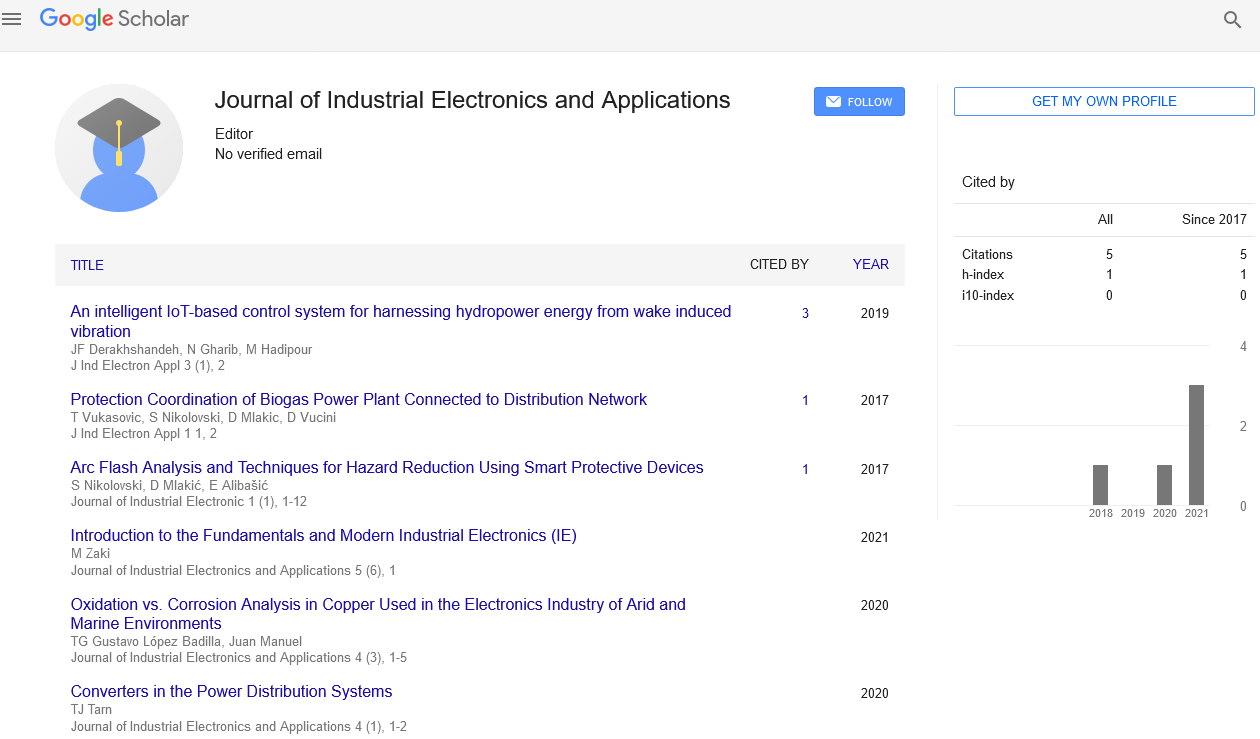Opinion Article, J Ind Electron Appl Vol: 7 Issue: 1
Sensors, Actuators and Systems Integration: Bridging the Gap for Smart Technologies
Lei Feng*
1Department of Machine Design, KTH Royal Institute of Technology, Stockholm 10044, Sweden
*Corresponding Author: Lei Feng
Department of Machine Design, KTH Royal
Institute of Technology, Stockholm 10044, Sweden
E-mail: lfrejk@kth.se
Received date: 24 February, 2023, Manuscript No. JIEA-23-95947;
Editor assigned date: 28 February, 2023, PreQC No. JIEA-23-95947(PQ);
Reviewed date: 13 March, 2023, QCNo JIEA-23-95947;
Revised date: 21 March, 2023, Manuscript No. JIEA-23-95947(R);
Published date: 30 March, 2023, DOI: 10.4172/JIEA.1000025.
Citation: Feng L (2023) Sensors, Actuators and Systems Integration: Bridging the Gap for Smart Technologies. J Ind Electron Appl 7:1.
Description
Advancements in sensors, actuators, and systems integration have transformed the landscape of modern technologies, leading to the development of smart systems across various domains. Sensors provide the ability to capture data from the physical world, actuators enable the control and manipulation of physical processes, and systems integration facilitates the seamless integration of multiple components to produce intelligent systems. This manuscript provides a comprehensive overview of the latest developments in sensors, actuators, and systems integration, highlighting their applications and challenges in the era of smart technologies.
In recent years, smart technologies have emerged as a significant driver of innovation in fields such as healthcare, automotive, agriculture, manufacturing, and energy. These technologies rely on the integration of sensors, actuators, and systems to gather data, process it, and respond accordingly, enabling autonomous decision-making and operation. Sensors are devices that convert physical or environmental changes into electrical signals, while actuators are devices that enable the control of physical processes or systems. Systems integration involves the seamless integration of sensors, actuators, and other components to produce intelligent systems that can sense, process, and respond to the environment.
Sensors
Sensors play an important role in smart technologies by providing ability to measure and monitor various parameters in real-time. They come in a wide range of types, including optical, acoustic, magnetic, thermal, chemical, and biological sensors, each tailored for specific applications. For instance, optical sensors are used in autonomous vehicles to perceive the surrounding environment, while wearable sensors monitor vital signs in healthcare applications. Sensors are also employed in industrial settings for process control, environmental monitoring, and safety applications.
Actuators
Actuators are essential components in smart systems as they enable the control and manipulation of physical processes. They convert electrical signals or other forms of energy into mechanical or physical actions. Common types of actuators include motors, valves, pumps, switches, and robots. Actuators are used in a wide range of applications, such as robotics, automation, aerospace, automotive, and consumer electronics. For example, actuators in autonomous vehicles control the acceleration, braking, and steering, while in smart homes, actuators control the lighting, heating, and ventilation.
Systems integration
Systems integration is the process of seamlessly integrating multiple components, including sensors, actuators, processors, and communication modules, to produce intelligent systems. Integration is important for the proper functioning of smart technologies, as it allows different components to work together cohesively, share data, and make decisions based on the collective information. Systems integration enables the interoperability, scalability, and adaptability of smart systems, making them capable of responding to changing environments and requirements.
Applications
Sensors, actuators, and systems integration find applications in diverse domains. In healthcare, wearable sensors and actuators are used for remote patient monitoring, telemedicine, and assistive devices. In automotive, sensors and actuators enable autonomous driving, Advanced Driver Assistance Aystems (ADAS), and Vehicle-to- Everything (V2X) communication. In agriculture, sensors and actuators are employed for precision farming, irrigation management, and livestock monitoring. In manufacturing, sensors and actuators are utilized for process monitoring, quality control, and predictive maintenance. In energy, sensors and actuators enable smart grids, energy management systems, and renewable energy integration.
Challenges
Despite the tremendous progress in sensors, actuators, and systems integration, there are several challenges that need to be addressed. One major challenge is the need for standardization and interoperability among different sensors, actuators, and systems. The lack of common standards and protocols can hinder the seamless integration of different components, leading to compatibility issues and increased complexity. Another challenge is the need for efficient data processing and analysis.
 Spanish
Spanish  Chinese
Chinese  Russian
Russian  German
German  French
French  Japanese
Japanese  Portuguese
Portuguese  Hindi
Hindi 